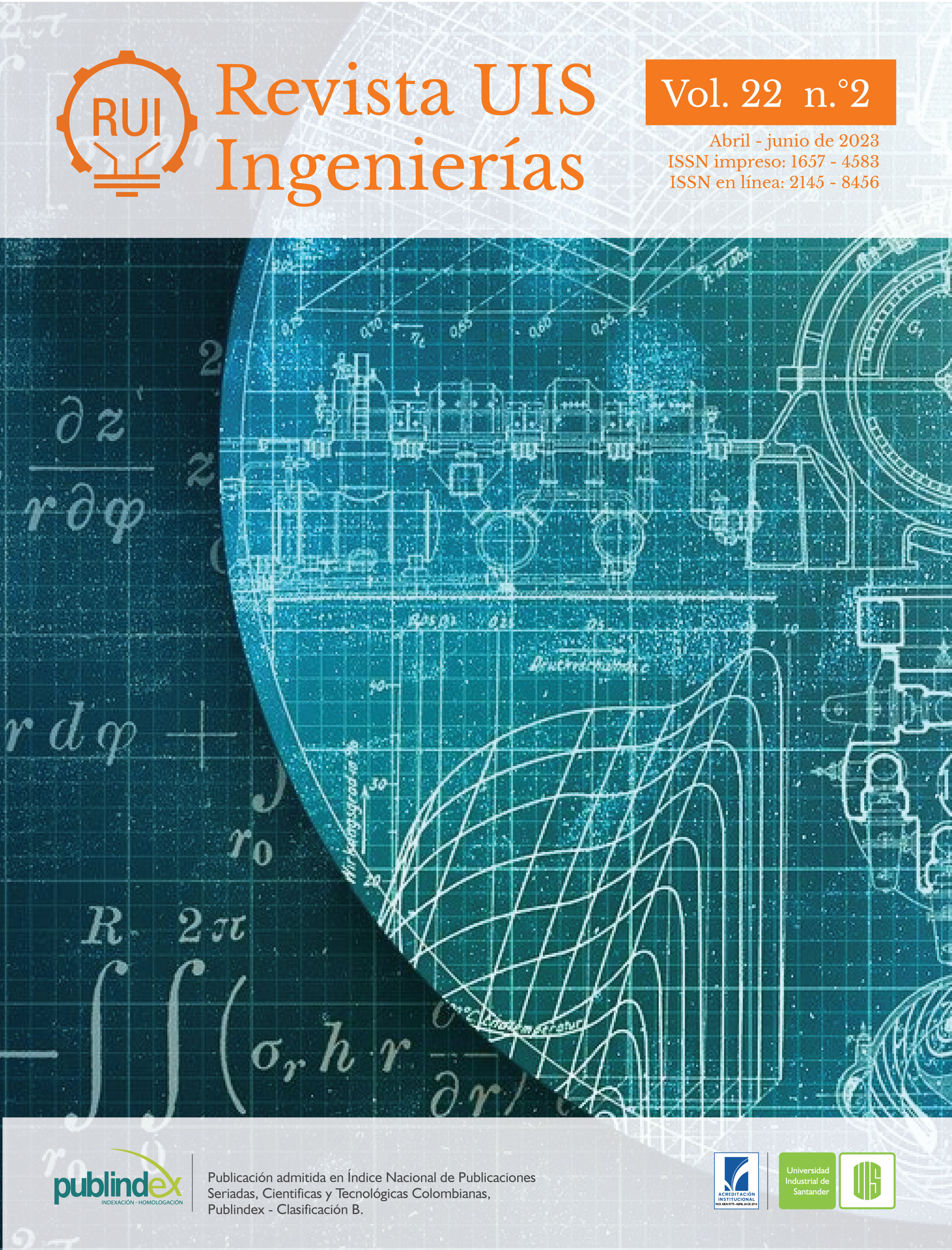Electric propulsion powered by hydrogen cells: Impact on carbon footprint mitigation
Published 2023-04-03
Keywords
- Hydrogen,
- fuel cell,
- electric propulsion,
- greenhouse gases,
- CO2 emissions
- global temperature,
- logistic support vessel and cabotage,
- maritime industry,
- fluvial industry,
- power generation source ...More
How to Cite
Copyright (c) 2023 Revista UIS Ingenierías

This work is licensed under a Creative Commons Attribution-NoDerivatives 4.0 International License.
Abstract
The increase in global temperature, as a result of greenhouse gas emissions, continues to be a major concern that has led to a deep interest in the implementation of hydrogen as a source of electric power generation; therefore, hydrogen fuel cell technologies have been developed and are available on the market to mitigate CO2 emissions generated by the use of fossil fuels. This document describes the methodology used for the design of an electric propulsion system with energy supply from a hydrogen fuel cell in a Light Cabotage and Logistic Support Vessel - BALC-L. The current design of the vessel has a conventional propulsion with two diesel engines of 224 bkW each and two diesel generators 99 ekW each, as the basis for the proposed analysis of an electric propulsion system energized through a hydrogen fuel cell system. As a result, a change in the operational profile of the vessel and a reduction in the CO2 emissions that it would generate throughout its useful life cycle are identified. The research described in this document is a starting point for the implementation of these technologies in the maritime and fluvial industry in Colombia.
Downloads
References
- Ballard Power Systems, “Fuel Cell Applications for Marine Vessels: Why fuel cells make sense”, Ballard, 2019, [En línea]. Disponible en: https://www.ballard.com/docs/default-source/default-document-library/marine-informational-paper-final.pdf?sfvrsn=c1cec080_2
- A. Bordianu, G. Samoilescu, “Electric and hybrid propulsion in the naval industry”, 2019 11th International Symposium on Advanced Topics in Electrical Engineering (ATEE), Bucharest, Romania, 2019, pp. 1-6, doi: https://doi.org/10.1109/ATEE.2019.8725022
- M. G. Sürer, H. T. Arat, “Advancements and current technologies on hydrogen fuel cell applications for marine vehicles,” International Journal of Hydrogen Energy, vol. 47, no. 45, 2022, doi: https://doi.org/10.1016/j.ijhydene.2021.12.251
- A. Elkafas, M. Shouman, “A Study of the Performance of Ship Diesel-Electric Propulsion Systems From an Environmental, Energy Efficiency, and Economic Perspective”, Marine Technology Society Journal, vol. 56, nº 1, pp. 52-58, 2022, doi: https://doi.org/10.4031/MTSJ.56.1.3
- N. Ammar, I. S. Seddiek, “Evaluation of the environmental and economic impacts of electric propulsion systems onboard ships: case study passenger vessel”, Environmental Science and Pollution Research, vol. 28, nº 28, pp. 1-16, 2021, doi: https://doi.org/10.1007/s11356-021-13271-4
- E. E. Agency, EMSA, “European Maritime Transport Environmental Report 2021”, EMSA, European Environment Agency, London, 2021.
- A. Ait Allal, K. Mansouri, M. Youssfi, M. Qbadou, “Toward an evaluation of marine fuels for a clean and efficient autonomous ship propulsion energy”, Materials Today: Proceedings, vol. 13, pp. 486-495, 2019, doi: https://doi.org/10.1016/j.matpr.2019.04.005
- Gobierno de Colombia, “Actualización de la contribución Determinada a Nivel Nacional de Colombia (NDC)”, Ministerio del Medio Ambiente, 2020.
- IDEAM, PNUD, MADS, DNP y FMAM, “Tercera Comunicación Nacional de cambio climático: Inventario Nacional de gases de efecto invernadero (GEI)”, 2016.
- H. P. Nguyen, A. T. Hoanget al., “The electric propulsion system as a green solution for management strategy of CO2 emission in ocean shipping: A comprehensive review”, International Transactions on electrical energy systems, vol. 31, no. 11, 2021, doi: https://doi.org/10.1002/2050-7038.12580
- N. Chalermkiat, L. Tie, X. Hongpu, “Design of Cost-Effective and Emission-Aware Power Plant System for Integrated Electric Propulsion Ship”, Journal of Marine Science and Engineering, vol. 9, pp. 1-32, 2021, doi: https://doi.org/10.3390/jmse9070684
- R. Derollepot, E, Vinot, “Sizing of a combined series-parallel hybrid architecture for river ship application using genetic algorithm and optimal energy management”, Mathematics and Computers in Simulation, vol. 158, pp. 248-263, 2019, doi: https://doi.org/10.1016/j.matcom.2018.09.012
- C. Nuchturee, T. Li, H. Xia, “Energy efficiency of integrated electric propulsion for ships–A review”, Renewable and Sustainable Energy Reviews, vol. 134, pp. 1-25, 2020, doi: https://doi.org/10.1016/j.rser.2020.110145
- V. Biert y et al, “A review of fuel cell systems for maritime applications”, Journal of Power Sources, vol. 327, pp. 345-364, 2016, doi: https://doi.org/10.1016/j.jpowsour.2016.07.007
- Armada de Colombia, “Plan de Desarrollo Naval 2042”, Colombia , 2020.
- COTECMAR, “Concepto técnico, Resumen Diseño Contractual BALC-L”, Colombia, 2021.
- Institute of Electrical and Electronics Engineers, “IEEE 45 Recommended Practice for Electric Installations on Shipboard» IEEE, New York, 2002.
- MinEnergía, “Hoja de ruta del hidrógeno en Colombia”, Colombia, 2021.
- J. Andersson, S. Grönkvist, “Large-scale storage of hydrogen”, International journal of hydrogen energy, vol. 44, no. 23, pp. 11901-11919, 2019, doi: https://doi.org/10.1016/j.ijhydene.2019.03.063
- M. Carmo, D. Fritz, J. Mergel, “A comprehensive review on PEM water electrolysis”, International journal of hydrogen energy, vol. 38, nº 12, pp. 4901-4934, 2013, doi: https://doi.org/10.1016/j.ijhydene.2013.01.151
- N. Shakeri, M. Zadeh, J. Nielsen, “Hydrogen fuel cells for ship electric propulsion: Moving toward greener ships”, IEEE Electrification Magazine, vol. 8, nº 2, pp. 27-43, 2020, doi: https://doi.org/10.1109/MELE.2020.2985484
- M. Becherif, et al, “Hydrogen energy storage: new techno-economic emergence solution analysis”, Energy Procedia, vol. 74, pp. 371-380, 2015, doi: https://doi.org/10.1016/j.egypro.2015.07.629
- M. Okundamiya, “Integration of photovoltaic and hydrogen fuel cell system for sustainable energy harvesting of a university ICT infrastructure with an irregular electric grid”, Energy Conversion and Management, vol. 250, 2021, doi: https://doi.org/10.1016/j.enconman.2021.114928
- A. Lanz, J. Heffel, C. Messer, “Hydrogen fuel cell engines and related technologies”, United States Federal Transit Administration (FTA), 2001.
- L. V. Biert, M. Godjevac, K. Visser, P. V. Aravind, “A review of fuel cell systems for maritime applications”, Journal of Power Sources, vol. 327, pp. 345-364, 2016, doi: https://doi.org/10.1016/j.jpowsour.2016.07.007
- S. M. J. M. Z. Katalenich, «Toward battery electric and hydrogen fuel cell military vehicles for land, air, and sea» Energy, vol. 254, 2022, doi: https://doi.org/10.1016/j.energy.2022.124355
- American Bureau of Shipping, “Guide for fuel cell power systems for marine and offshore applications”, ABS, Texas, 2019, [En línea]. Disponible en: https://img.fuelcellsworks.com/wp-content/uploads/2019/12/Fuel-Cell-Power-Systems-For-Marine-and-Offshore-Applications.pdf

